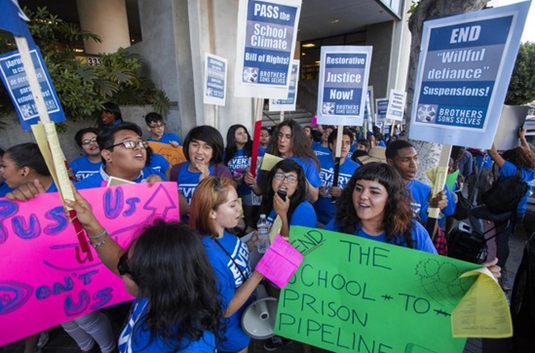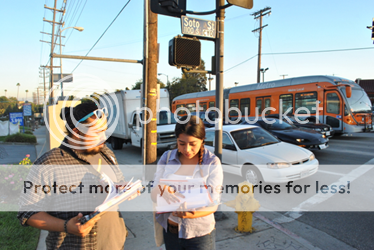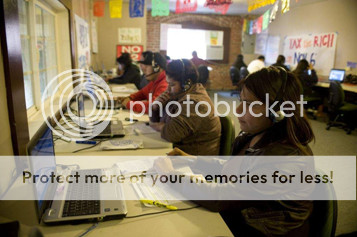L.A Schools Rethink Suspensions | The Wall Street Journal
LOS ANGELES—Damien Valentine was suspended from school for the first time as a seventh-grader in South Central Los Angeles, after arguing with a math teacher who had asked him to change seats.
Mr. Valentine, now a 16-year-old sophomore, said he was sent home for a day-and-a-half for "willful defiance," a term encompassing a variety of misbehavior that California schools can use as reason to remove students from the classroom.
This week, the Los Angeles Unified School District—the second-largest in the nation—decided to end the practice of suspending or expelling students for "willful defiance," starting this fall. District officials said the practice disproportionately affects minority students' education and leads to more disciplinary problems for students down the line.
by the district's school board "ends a policy that failed to keep our students learning or our streets safe," said district board member Nury Martinez.

Rally at the Los Angeles Unified School District Meeting | Los Angeles Times
The Los Angeles Unified school board voted Tuesday to ban suspensions of defiant students, directing officials to use alternative disciplinary practices instead.
Los Angeles Unified has become the first school district in the state to ban defiance as grounds for suspension.
Read moreBringing Restorative Justice to Mendez Learning Center
On March 15th, 2013, InnerCity Struggle hosted a lunch-time event at Mendez Learning Center in Boyle Heights to raise awareness about Restorative Justice policies. Friday’s event was part of an Educational Justice Week program where youth organizers from InnerCity Struggle have conducted classroom workshops to students at Mendez Learning Center focused on the impacts of the ‘school to prison pipeline’ and to promote higher education.
Student leaders of InnerCity Struggle’s youth component, United Students, are working on a “School Climate Student Bill of Rights” campaign with a coalition of Los Angeles County organizations called Brothers, Sons, Selves (BSS). The campaign is focused on reducing the rate of suspensions and expulsions that disproportionately affect young students of color, particularly young men of color.
Read moreBuscan plan para escuela Roosevelt del Este de Los Ángeles | La Opinion
Los 2,900 estudiantes que conforman el cuerpo estudiantil de la legendaria preparatoria Roosevelt del Este de Los Ángeles, debaten actualmente su futuro.
Después de haber luchado por años por reducir la sobrepoblación estudiantil y buscar maneras de elevar el nivel académico que por décadas dejaba mucho que desear, en el ciclo escolar 2010-2011, bajo la dirección de la Partnership for Los Ángeles Schools (PLAS), esta escuela fue dividida en 7 pequeñas escuelas independientes.
Read moreFive Myths of Talking About Race With Your Child
I get a lot of mixed feedback when I say that adults need to learn to speak openly about race with young children. They are afraid of spoiling their childhood or crushing their natural curiosities. However, when we look at the root causes of racial inequity in this country, we see that they grow out of the lessons we learn in our earliest years. In fact, honest conversations about race have a positive impact on children, honoring their observations and lived experiences, and better preparing them to recognize and undo social injustice in their lives. Then, why don’t we do it more?
The truth is that most of us adults have incomplete and competing ideas about the role of race in our own lives. Young children’s comments often illuminate theuncomfortable gap between our good intentions and the thorny truths of the world.
Read moreBrown's school funding plan draws mixed reactions | Los Angeles Times
In the Anaheim City School District, where most students are low-income and struggling to learn English, teachers need special training, extra tutoring time and lots of visual materials to help their pupils achieve at grade level.
In the well-heeled Palos Verdes Peninsula Unified School District, poverty and limited English are not widespread problems. But officials there say their student needs include more expensive Advanced Placement classes to challenge them with college-level material in high school.
Read moreFive Myths of Talking About Race With Your Child | RISE
I get a lot of mixed feedback when I say that adults need to learn to speak openly about race with young children. They are afraid of spoiling their childhood or crushing their natural curiosities. However, when we look at the root causes of racial inequity in this country, we see that they grow out of the lessons we learn in our earliest years. In fact, honest conversations about race have a positive impact on children, honoring their observations and lived experiences, and better preparing them to recognize and undo social injustice in their lives. Then, why don’t we do it more?
The truth is that most of us adults have incomplete and competing ideas about the role of race in our own lives. Young children’s comments often illuminate the uncomfortable gap between our good intentions and the thorny truths of the world.
In my experience over the past two years facilitating Border Crossers‘ ”Talking About Race With K-5″ workshops and seminars, I have had the opportunity to share struggles, dissect scenarios, analyze the institutions around us, and offer support in developing and implementing concrete tools and strategies with over 400 educators, activists and parents. I have learned a tremendous amount from each of them.
Over and over, I hear the same excuses for why adults don’t have conversations about race with children. In this article, I dissect five common myths of talking about race with children and offer a few simple sentence starters that help reframe the approach.

1. “Children don’t see race.”
Research shows us that children do, in fact, see race. They are never “colorblind.” One study revealed that infants recognize racial differences between three and six months of age. Dr. Phyllis Katz’s research (as cited in “See Baby Discriminate” ) shows that by three years white children exhibit an overwhelming preference for same-race friends. By age five, 68% of children sort decks of cards of people’s faces by race over any other indicator. The infamous doll test originally performed by Kenneth and Mamie Clark and repeated most recently by CNN’s Anderson Cooper 360 shows that pre-k and kindergarten-aged children express racial biases that remain with them through adulthood.
To be clear, the purpose of this research is not to figure out if your child is a racist or not. The intention is to debunk the colorblind myth and frame an approach to interrupting these troubling patterns.
Here’s something you can try:
Read more
Organizing and Partnering for School Change in East Los Angeles | Huffington Post
For more than 80 years, no new school was built in East Los Angeles. In the past several years, the efforts of a community organizing group, a dedicated group of teachers, an array of community partners, the students, and the parents converged to demand change -- and to make it a reality. Now the Esteban E. Torres High School is a beacon of hope and opportunity in this low-income, largely Latino neighborhood. InnerCity Struggle (ICS) and Los Angeles Education Partnership (LAEP), organizations that played key roles in the development of Torres, continue their strong partnerships with Torres to support success of the school.
InnerCity Struggle is an East Los Angeles-based community organizing group; ICS has worked with youth and community residents since 1994 to promote safe, healthy, and non-violent communities in the Eastside. It organized students, residents, and educators through petition drives, community meetings, mobilizations, and rallies to secure the construction of Esteban E. Torres High School in 2004.
Read moreCanvassers Get Out the Vote, One Block at a Time | La Streets Blog
Election information and clipboard in hand, Evelyn Leon called out to the house as she tip toed up steps leading to the front door. She is scared of unruly dogs in people’s homes she said, so she tries to make enough noise to draw one out if its there. In the end, no one is home.
Leon and more than 231 volunteers from Inner City Struggle phone banked and canvassed this election cycle to Eastside residents, and specifically youth, immigrants, and new voters. ICS’s ”Yes on 30″ and “No on 32″ campaign has had staggering results: ICS volunteers and staff spoke to 24,000 Eastside residents – East LA, Boyle Heights, and 1 precinct in El Sereno and Lincoln Heights – with 19,000 pledging their support. For door-to-door canvassers, volunteers spoke to 3,900 people and received pledges from 3,060, said Lydia Avila-Hernandez, ICS director of community organizing.

Read more
Promueven el voto latino en Los Ángeles | La Opinion
“Jóvenes voluntarios del centro de llamas del Califonia Call Action Fund llaman a votantes lationos del Este de Los Angeles para recordarles que salgan a votar el próximo martes.”
A dos días de las elecciones presidenciales, distintascoaliciones del condado de Los Ángeles
continúan luchando intensamente para sacar el voto latino a la calle en forma masiva.
Una coalición formada por California Calls, Lucha del Pueblo (Inner City Struggles) y SCOPE realizó ayer una jornada para pedir a los residentes del Este de Los Ángeles y otras áreas de la ciudad que salgan este martes a votar y sean la voz de aquellos que luchan por sus derechos pero que no pueden ejercer el voto.
